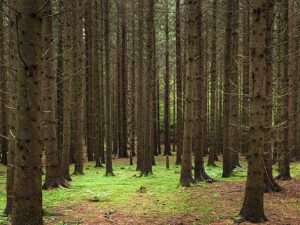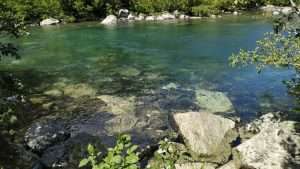 A shiny new study just came out detailing nature’s restorative effects, specifically on children and adolescents. It’s an in-depth literature review that not only demonstrates the effectiveness of nature as a therapeutic tool, but supports the future use of standardized measures to make the study of ecopsychology, ecotherapy and similar practices more scientifically rigorous. The study is just the latest in a long line of research showing how nature makes us feel better.
A shiny new study just came out detailing nature’s restorative effects, specifically on children and adolescents. It’s an in-depth literature review that not only demonstrates the effectiveness of nature as a therapeutic tool, but supports the future use of standardized measures to make the study of ecopsychology, ecotherapy and similar practices more scientifically rigorous. The study is just the latest in a long line of research showing how nature makes us feel better.
Earlier this year, I wrote an article on nature’s effects on the brain. Mobile EEGs are able to record changes in the brain as study participants spend time outdoors, and multiple studies use their readings. This is an example of a more quantitative approach to studying the restorative effects of nature, in which certain metrics can be measured reliably over and over again.
But what, exactly, happens when nature makes us feel better? Let’s look at some of the measurable effects. (Note: I drew from a previous article of mine from several years ago for the following material, though it was a great opportunity to check in on more recent research.)
Physical Ways Nature Makes Us Feel Better
Increased Immune Function: This extensive literature review shows that time spent in nature improves immune function on a variety of levels. Studies show how time in nature can increase the number of white blood cells that help fight infection and other ailments: in senior citizens after exercising, and after forest bathing.
Improved Vision: Children are less likely to develop myopia (near-sightedness) when they spend more time outside. This study suggests that dopamine is a key player in this phenomenon. A literature review further supports the connection between eyesight and outdoor time.
 Lower Blood Pressure: A 2020 study suggests that exposure to the UV light in sunshine can lower blood pressure. So can thirty minutes of outdoor activity (along with lowering symptoms of depression.) Forest bathing was shown to lower blood pressure in older people in a 2012 study. This study posits that nature’s effect on blood pressure may be accomplished through calming the sympathetic nervous system.
Lower Blood Pressure: A 2020 study suggests that exposure to the UV light in sunshine can lower blood pressure. So can thirty minutes of outdoor activity (along with lowering symptoms of depression.) Forest bathing was shown to lower blood pressure in older people in a 2012 study. This study posits that nature’s effect on blood pressure may be accomplished through calming the sympathetic nervous system.
Improve Socioeconomic Conditions: Decreasing poverty is an incredibly important part of increasing intergenerational mobility in socioeconomically disadvantaged people. This 2019 study suggests that access to greenspace can reduce the chance of poverty by boosting creativity, emotional regulation, and academic performance. Another study links boosts in creativity with forest bathing, one particular use of greenspace. Moreover, greenspaces can also lower crime rates, another significant factor in improving conditions in disadvantaged communities.
As if all that wasn’t enough, this massive, comprehensive literature review has evidence that time in nature can not only lower blood pressure and resting heart rates, but also reduce the chances of heart disease, diabetes, and overall mortality. Speaking of mortality, here’s a study looking at how greenspace in particular can lower mortality in a stable community. And another one looking at lower mortality rates in urban areas with greenspace. And in case you thought that the effects of outdoor exercise was all about the exercise and not the setting, here’s one showing that mortality rates are lower when people specifically walk in greenspace.
Psychological Ways Nature Makes Us Feel Better
Reduced rumination: Psychological rumination is basically when your mind gets stuck on some worry, painful memory, or other negative thoughts. It’s commonly associated with anxiety and depressive disorders. Unlike meditation or problem-solving thoughts, rumination doesn’t actually help a person make any changes to their distress, and may actually make it worse, like incessantly poking at a bruise.
Time in nature has been shown to reduce rumination in study participants. A 2021 study demonstrates that spending a dedicated amount of time in nature each week significantly reduces rumination as well as negative affect (in other words, a bad mood.) You don’t need to spend hours out there, though; a half an hour may be enough to see a difference. It needs to be actual nature, though, as this 2018 study shows; people who viewed a slideshow of nature photos did show an improvement in affect, but no reduction in rumination.
Cognitive Function: Time in nature can help sharpen our mental capacity in a number of ways. This thorough, multidisciplinary literature review explores several of the ways nature is restorative, and also suggests some ways to further categorize these effects to increase consistency in future research. Hospitals that have significant greenspaces are easier to navigate due to improved spatial awareness, mood, and other factors. Cognitive performance can even be boosted simply by listening to the sounds of nature. Working memory may be improved through time spent in nature. Time outside can counteract attention fatigue, that feeling when your mind is so tired you just can’t focus. Can’t get outside? Even looking out a window can improve attention. And it may only take a very short period of time to start getting positive cognitive effects.
Stress Reduction: Stress can seriously strain cognitive functioning, from attention to memory and more, never mind overall mental well-being. So reducing stress is a good idea all around. A twenty minute walk in nature was shown to lower levels of cortisol, a stress-related hormone. A 2022 study compared the activity of the amygdala–sort of the brain’s panic button–before and after time spent in nature. The amygdala was much less active after a walk outside. Most studies have participants engage in a specific activity over a set amount of time and often in the same location to help remove confounding variables. However, a 2019 study that allowed participants to set their own parameters for where and when they would have their nature experiences showed that they still had significant drops in cortisol after being outside.
 A Healthier Environment: Workers who are able to look out on a greenspace fare better than those who don’t. While virtual reality greenspaces can contribute some benefit, it’s better to go with the real deal, and the more biodiversity, the better. As mentioned earlier, hospitals with greenspace not only improve cognitive performance, but they’re also more pleasing to staff and patients alike. This literature review supports the therapeutic value of healing gardens in hospitals. (Note: These studies often cover both physiological and psychological benefits of greener built environments.)
A Healthier Environment: Workers who are able to look out on a greenspace fare better than those who don’t. While virtual reality greenspaces can contribute some benefit, it’s better to go with the real deal, and the more biodiversity, the better. As mentioned earlier, hospitals with greenspace not only improve cognitive performance, but they’re also more pleasing to staff and patients alike. This literature review supports the therapeutic value of healing gardens in hospitals. (Note: These studies often cover both physiological and psychological benefits of greener built environments.)
A Sense of Awe: Nature inspires us to experience deep feelings of awe, which has been shown to improve mental well-being in multiple demographics. This transcendent experience can be incredibly healing and formative. Even better, the experience of feeling awe in nature can lead to more eco-friendly behavior by making people feel more connected to the natural world.
Soft Fascination: This is a term coined by researchers Rachel and Stephan Kaplan to refer to the more relaxed, organic way our attention flows when we are in a nature-dominated environment as opposed to a largely artificial one. A 2019 study demonstrates that it simply takes less mental effort for us to view natural scenes. We also find spending time in nature to be more restorative than watching TV for the same reasons. Also, for the fun of it, here’s a neat study exploring the intersection of soft fascination, sense of humor, and mental well-being.
Resilience: Social distancing due to the COVID-19 pandemic prompted studies on how nature can increase resilience, including this one on urban nature, and another on adolescents’ mental well-being.
Postscript
 Studies showing the benefits of nature are just one step in making use of nature’s restorative properties. One of the themes you’ll run into again and again when exploring this topic is that greenspace is most definitely not evenly distributed, especially in urban areas. Wealthy and privileged communities have disproportionately greater amounts of greenspace compared to socioeconomically disadvantaged ones, which makes the issue of mental health and nature based therapy a social justice issue.
Studies showing the benefits of nature are just one step in making use of nature’s restorative properties. One of the themes you’ll run into again and again when exploring this topic is that greenspace is most definitely not evenly distributed, especially in urban areas. Wealthy and privileged communities have disproportionately greater amounts of greenspace compared to socioeconomically disadvantaged ones, which makes the issue of mental health and nature based therapy a social justice issue.
Moreover, many natural places are not accessible to disabled people. A significant lack of infrastructure to get disabled people to these spaces, and then allowing them to explore them as extensively as non-disabled people, means that there is a serious disparity. While there are efforts toward equality in this area as well, there is still plenty of room for improvement.
Finally, nature should not only exist for our benefit, but for its intrinsic value independent of our human agendas and biases. While personal restoration and rejuvenation are certainly good things to enjoy whenever we get the opportunity to go outside, and we shouldn’t feel any guilt or shame for how nature makes us feel better, I think it is very important that we not take our greenspaces for granted, and work to make sure they are preserved and restored for generations to come.
